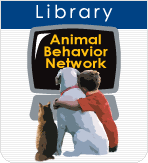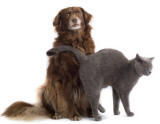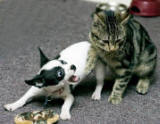|
Need Help? |
|
Call
1-800-372-3706
to
speak to a Veterinary Behavior Technician |
|
Paws for Help!
|
|

Click on Library Icon |
|
Help is at your
fingertips
by
library, email
and phone! |

Helpful Link
Aggression toward Cats


 |
|
Dog Behavior Library
|
The
Dog - Cat Peace Process
Prevention
is Easier than Correction
Like
everything else in life, it is
easier to prevent problems
between cats and dogs than it is
to correct the problem.
The best time to introduce cats
to dogs is when both are very
young. Both cats and dogs accept
other species more easily when
they are in their primary
socialization periods.
Developmentally, this period
starts and ends sooner with
kittens than puppies. What
kittens learn before 10 weeks of
age and what puppies learn
before 16 weeks of age makes a
lifelong impression
|
In difficult
severe cases, this peace
process might takes weeks
or longer. Trying to push
it too quickly will cause
the problem to worsen, instead
of improve. |
Brokering An Agreement
If you already have a home turf
war going on, here are some
tips on how to achieve peace:
|
1)
|
Separate
the parties for a "cooling
off period" ranging
from a day to a week. If
possible, this means no
eye contact. Also, during
the entire peace process,
isolate them from each other
unless you are there to
supervise. |
|
2)
|
While isolated from each
other, introduce each
other's scent. Rub a towel
on the dog, and place it
near where the cat sleeps.
Do the reverse for the dog.
This exposure to the scent of the other
is part of the desensitization
process, and starts building
a bond. |
|
3) |
If
the dog is not really sharp
on obedience Instructions, join
a refresher course to be
sure you have a strong positive
leadership position and
verbal control. Use rewards,
interrupt negative behavior,
and avoid any physical punishment.
Work on the LONG DOWN STAY
Instruction. If this Instruction
is difficult for your dog,
teach "Close Tethering"
where the dog is tethered
on a 6 foot chain leash
with a chew toy, close to
a person, and praised for
quiet resting. |
|
4)
|
Give "off the property"
leash exercise to the dog,
and drag a string to exercise
the cat. Exercise relieves
a lot of tension. |
|
5) |
This
is also a great time to
teach the dog to wear a
head halter like the "Gentle
Leader" (available
from Premier Pet Products,
800-933-5595). This decreases
reactivity, encourages calm
behavior, and allows effective
control of even a charging
big dog. This tool also
makes it easy to walk any
dog while preventing pulling
on the leash. |
|
6)
|
Get
a large molded plastic portable
kennel, and feed the cat
in it for at least a week.
Feed meals not "free
choice". In between
meals, leave the door open
with a comfy bed inside. |
|
7) |
Begin
feeding both pets at the
same time within eye contact
but otherwise from a distance.
The dog is either tethered
or on a long-down-stay,
and the cat is inside his
or her "safe place"
portable kennel, with the
door locked for safety. |
|
8) |
In
addition to the meals, prepare
some REALLY special treats.
Use these to reward relaxed
postures, and ignoring the
other being. Move the kennel
closer to the tethered dog,
as long as BOTH are relaxed.
If either gets tense, move
the kennel farther away. |
|
9)
|
During
these desensitization sessions,
give special attention to
each while the other watches.
The goal is for each to
think, "The big boss
seems to like him, and all
the good things seem to
happen when he is near by."
During the peace process
(except during this feeding
treat and praise, "happy
hour".) Give each
pet the "cold shoulder"
treatment, so that they
become motivated for attention,
and associate getting attention
with the former enemy. |
|
10) |
Once
the cat in the kennel can
be right next to the dog,
and the dog loses interest
in sniffing, let the cat
patrol while the dog is
tethered. Next mealtime,
reverse to leave the cat
in the carrier and the dog
to patrol. Be there
to interrupt but not physically
punish barking, or pawing
or gnawing the kennel. Praise
the dog and give treats
anytime he ignores or acts
relaxed around the cat. |
|
11) |
The
next step is to have the
dog tethered while you
play with the cat. Try dragging
a string or other toy designed
to get the cat to run. If
the dog gets excited and
tries to pull on the tether,
you are going too fast.
Back up to previous steps,
and try simply holding the
cat on your lap, giving
special grooming and petting
and treats, while the dog
watches YOU "accept"
this being.
|
|
12) |
If
problems persist, seek
the services of a qualified
professional by contacting
the American College of
Veterinary Behaviorists
(800/248-2862), the American
Veterinary Society of
Animal Behavior (www.avma.org/avsab/profile.html),
the Animal Behavior Society
(www.animalbehavior.org),
or the Animal Behavior
Network (www.AnimalBehavior.Net).
|
Treaty
As you begin trust them together, begin
letting both be unrestrained but with the dog wearing the
Gentle Leader and dragging a
10 foot lead to give you
some control. Make sure the
cat has plenty of places to
get up high, away from the dog.
If the dog gets close, and the
cat swipes the dog's face,
support the cat. It means the
dog was being inappropriate,
and the cat was just teaching
proper manners.
Peacekeeping
The final step is delivering
"aid" to peaceful
individuals. Determine a "special
treat" for each party.
Usually, this is a tasty food
morsel, but some dogs really
like squeaky toys, or a tug
of war game (for non-aggressive
dogs). The goal is for each
to suppress his or her
tendency for conflict, in order
to receive his or her very own peace offering.
|
|
|